The Sweet Art of Fostering
A few thoughts on what it takes and why it matters.
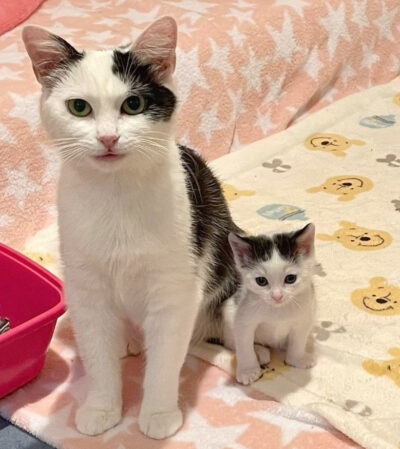
Welcoming a foster feline into your home not only helps the cat develop social skills and get ready for adoption, but it also frees up precious shelter real estate to make room for a few more. And for cats with special needs, fostering can make all the difference. As if this weren’t enough, there’s the “love factor” — whatever you give to your foster pet will come back to you many times over in the form of profound satisfaction and joy.
I’m grateful to be able to foster on a fairly large scale, but whatever your situation, you, too, can nurture a precious life through fostering. The best place to start is with your local shelter, which should provide you with background info on your foster pet and plenty of guidance. Rescue organizations often have different philosophies about fostering. North Shore Animal League America, for instance, primarily fosters out animals who have medical, behavioral, or special needs or require hospice care.
According to Jenna Martiello, who coordinates the Foster Care Program at Animal League America, the program currently handles 38 foster cases, 13 of which are hospice cases. So far in 2021, 86 pets have graduated from the program and been adopted. In 2020, when many people decided to combat Covid with compassion, an amazing 404 (!!) fosters graduated from the program.
Jenna says that if you’re thinking about fostering the most important things to remember are to be patient, to stay calm and ask questions, and to realize from the start that the goal is to help the pet prepare to leave you. As she puts it, “goodbye is the goal.”
I totally agree with Jenna. I’ve learned a lot since I began fostering more than a decade ago, most importantly that no two animals are alike, that I don’t foster “cats” — I foster individuals — and that each of those individuals has a lot to teach me.
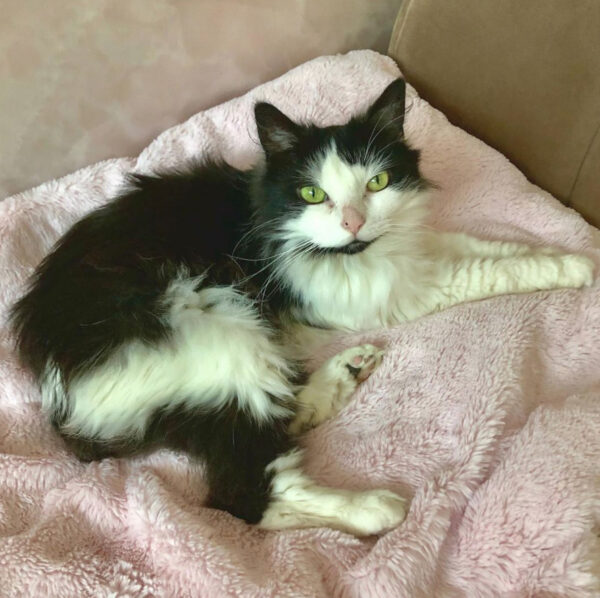
Bobtail foster Mini is 10 years old, very tiny, and loves to cuddle on her foster room blanket. I can’t figure out why her family left her at a local shelter but kept their other cats. She did not do well in the shelter but is thriving here in a home environment…that’s what fostering is all about!
Here are a few of the most practical things I’ve learned along the way that I think are useful whether you’re fostering one cat, a mama cat with a litter, or a kitten. The point is: If I can do it, you can too!
- Create a foster room. Keep in mind that even a small space, like a bathroom, is all you need. Think about it: If you’re a cat, even a bathroom is more spacious, comfy, and fascinating than a cage at a shelter!
- Put all your supplies in your designated foster room to create a fun and cozy space. Include a litter box (appropriate size: smaller for kittens and more than one for multiple fosters), litter, scooper, canned and dry food, food bowls, beds, blankets, toys, and scratchers.
- Take time each day to socialize with your foster(s), petting and cuddling with them, playing with them with toys. This, obviously, is the most fun part of fostering and it’s a great time to get to know their personalities — whether they’re lap cats, purr-ers, or whatever sets them apart. But besides being fun, socializing prepares cats to live in a home, which is the goal. It’s also the best time to take photos to help “market” them to forever families. I carry my iPhone with me at all times. That’s why I’m able to capture those magical moments that showcase their individual personalities.
Socializing also means determining if adult cats would do best as an only pet, so I “cat test” them with my resident cats. I also have my friends bring over a dog in case a potential family has a dog. I really don’t want to set up any of my fosters for failure in a home. They deserve the smoothest transition possible.

Adult beauty Phoebe loved to show off her belly fluff while playing with her mouse. After extensive dental surgery and the removal of serious mats, she came into her own and made the transition from foster to adopted without a hitch.
- Shakespeare famously asked, “What’s in a name?” Well, if he asked me, I’d say, “Plenty!” Which is why it’s important that your fosters have names. Howard supplies all the names at our house. He says that names are everything with the foster and takes his job very seriously. Names can express a lot about a pet. We love it when forever families keep his names, but are also totally fine when adopters rename their new family members. Howard named the blind and beautiful baby below “Nestle.” Any questions?
- Keep a foster journal. Write down things you notice as far as eating and litterbox usage as well as behavior so you can monitor any changes.

- If you’re working with shy kittens or cats, use baby food on a spoon or your finger or “squeeze up” treats (like baby food for kitties in a tube) to make them more comfortable and trusting of you. It’s important to touch and hold shy kitties every day. You want to build trust with them and help them be comfortable with human affection. I also use treats and wand toys to engage with kittens as well as my adult fosters. I spend as much time as I can with all to get a great sense of their personalities so I can match them with a perfect family.
- Adoption: We’re extremely picky about our adopters. For instance, I rarely adopt single kittens to families who have no other pets at home. People who are open to double adoptions go to the top of my pre-approve list. I prefer to adopt kittens in doubles. As the foster caregiver, you should be able to be involved with the shelter in the adoption process.
I asked Cindy Szczudlo, who is the Adoption Program Director for my foster program, called Beth’s Furry Friends, for additional insights. Cindy and I work together all the time.
“We make a connection with adopters to understand what their lives are like so we can make a good match,” says Cindy. “Gathering all the information first on an application — including address, job info, veterinary and personal references, and whether they want to adopt a kitten(s), adult cat(s), or if they’re interested in a senior cat or one with special needs. Also, it really helps to discuss their past and current pets so we have an understanding of the home they can provide. We must feel that they can be trusted to provide a caring, safe home after we rescue and nurture the fosters. Once we make a match, we go through all the supplies and how they should set up for their new cat. We also offer support if they have any questions after they adopt.”
Fostering has become my passion and purpose in life. I cannot put into words what an honor it is to care for these precious animals and how meaningful it is to see a shy cat become a lap cat or an injured kitten heal and blossom. As I mentioned, every rescue group has its own criteria and processes for fostering and adoption, but if you’re thinking about doing it, get in touch with a local organization and do it!
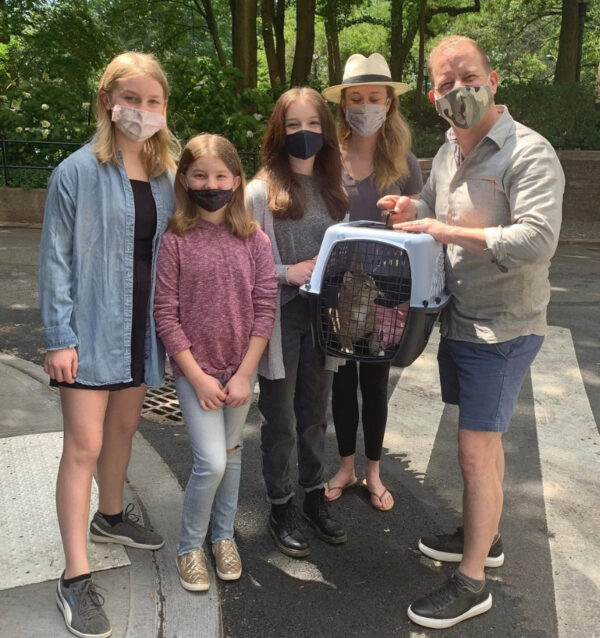
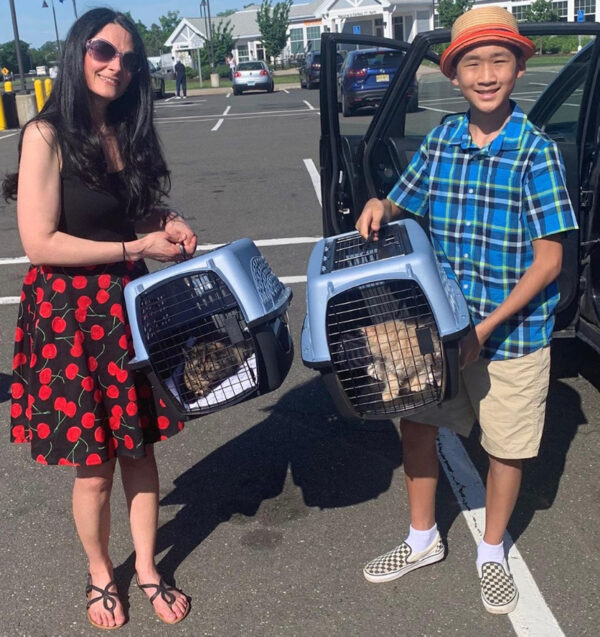
Adoption day, time to fly, and my heart is full.
Mama Boots goes home with her wonderful new family (left). Dad has yet another female to make happy! At right, Mama Cherry and her delightful Honor meet their new mama and human brother. That cherry skirt makes an adorable fashion statement!
As a foster parent, adoption day is the day you work and hope for. Letting go of one so you can open your heart to another. Although I have to confess, I never completely let go, because a part of each one remains in my heart forever. This is my bliss. I hope you’ll discover it for yourself.
xo
Beth
P.S. You will not be able to resist the story of a Maltese named Phoenix. Even People.com fell in love with this darling little survivor.
Phoenix arrived on Long Island via Animal League America’s recent rescue of 50 dogs from a horrific puppy mill in the Midwest. This sweet little guy has spent his entire life “working” in that terrible mill, and it took a toll on his health. He has heart disease and is in congestive heart failure. He requires three medications a day and will need repeated echocardiograms throughout the year. Phoenix has a guarded prognosis, and we wanted him to get out of the shelter environment as soon as possible and into a home so he could live surrounded by love for the time he has left. Well, shortly after I posted his story, that very special family came forward and he is thriving in his new home. He’s a special survivor, that’s for sure, and I pray that love heals his heart as it did for our Yoda after we adopted him eight years ago!

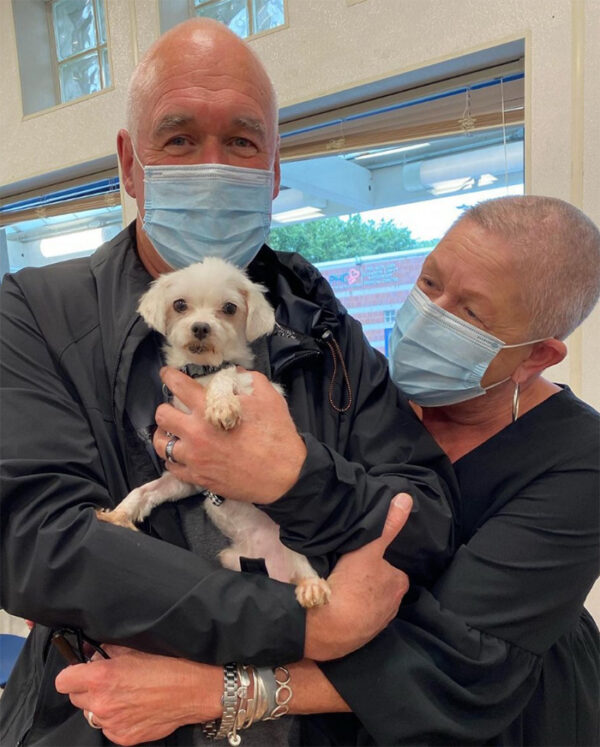
Phoenix and the very good people who adopted him. Check him out at @joeypminnick.
Yoda, below, almost disappears into the cushions while enjoying a brief rest between marathon brushing sessions with Howard.
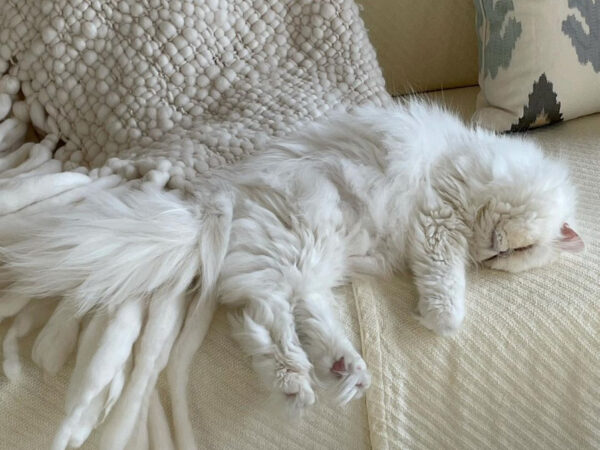
P.P.S. June is also National Microchip Month, a good reminder for all responsible pet people to do the smart thing and get your pet chipped. With summer here, doors will be opening and closing, and warm weather will beckon. Experts estimate that more than 10 million dogs and cats are lost and stolen in the U.S. every year. Chipped pets are much more likely to get back home. It’s painless and it works!


